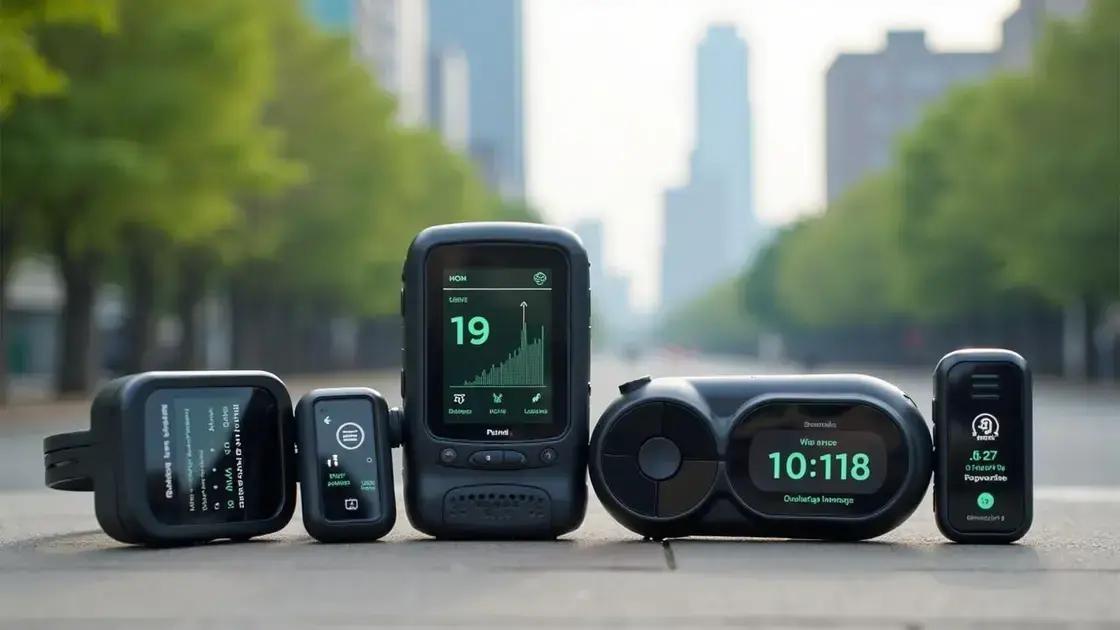Wearable air quality monitors significantly enhance men’s respiratory health by providing real-time data on environmental pollutants, allowing for informed decisions about outdoor activities and promoting awareness of air quality impacts on overall well-being.
As concerns about pollution and air quality rise, the importance of monitoring our environment becomes crucial, especially for men’s respiratory health. Wearable air quality monitors provide real-time data and insights into the air we breathe, empowering individuals to make informed decisions about their exposure to harmful pollutants. In this article, we’ll delve into understanding these devices, explore the impact of air quality on our respiratory systems, discuss their advantages for men in particular, and review future trends in this innovative field.
Understanding Wearable Air Quality Monitors

Wearable air quality monitors are devices designed to track environmental air quality in real-time. They provide crucial information about pollutants and allergens that can affect health. These monitors can be worn on the wrist, clipped onto clothing, or integrated into smartwatches. By utilizing sensors, they measure various air quality metrics such as PM2.5, VOCs, and humidity levels.
How Do They Work?
These devices utilize advanced sensors to detect harmful particles and gases in the air. PM2.5 refers to particulates smaller than 2.5 micrometers, which can penetrate deep into the lungs. VOCs are volatile organic compounds that can originate from household products, paints, and fuels. The monitors analyze air samples and communicate data through connected apps, which display real-time readings.
Types of Wearable Monitors
There are various types of wearable air quality monitors available today. Some are standalone devices, while others are integrated into fitness trackers or smartwatches. Many offer features such as GPS tracking, allowing users to see how air quality changes based on their location. Additionally, some devices provide customized alerts whenever the air quality worsens.
Benefits of Using Wearable Monitors
One of the main benefits is that they empower individuals to take control of their health. By understanding the air quality around them, users can avoid polluted areas, reducing their risk of respiratory issues. Furthermore, data collected can help identify trends over time, guiding lifestyle choices and promoting better health practices.
In summary, wearable air quality monitors play a vital role in raising awareness about environmental health. They encourage informed decisions that contribute to overall well-being, especially for men’s respiratory health.
Impact of Air Quality on Respiratory Health

The quality of the air we breathe directly affects our respiratory health. Poor air quality can lead to various health issues, particularly impacting the lungs and overall respiratory function. Pollutants such as particulate matter, ozone, and nitrogen dioxide can cause inflammation in the airways, making it harder to breathe.
Short-Term Effects
In the short term, exposure to polluted air can trigger symptoms in even healthy individuals. Common reactions include coughing, throat irritation, and shortness of breath. Those with pre-existing conditions like asthma may experience worsening symptoms. Research shows that high levels of air pollution can lead to increased hospital visits for respiratory issues.
Long-Term Effects
Over time, prolonged exposure to poor air quality can contribute to serious health problems. Chronic conditions such as chronic obstructive pulmonary disease (COPD) and lung cancer are linked to long-term air pollution exposure. Men, who may be more exposed to outdoor pollution due to occupational hazards, need to be especially mindful of their air quality.
Vulnerable Populations
Certain groups are more vulnerable to the impacts of air quality on respiratory health. This includes children, the elderly, and those with existing health conditions. Air pollution can stunt lung development in children and exacerbate chronic health issues in adults. Therefore, awareness and monitoring of air quality are crucial for these populations.
Monitoring air quality using wearable devices can help individuals make informed choices about when and where to engage in outdoor activities. By being proactive, men can protect their respiratory health from the adverse effects of air pollution.
Advantages of Wearable Monitors for Men

Wearable air quality monitors have several advantages for men, helping them stay healthy and informed about their environment. One of the most significant benefits is real-time monitoring. These devices allow men to track air quality on the go, which is extremely helpful for those who lead active lifestyles. Knowing when air quality is poor enables them to make better decisions regarding outdoor activities.
Promoting Awareness
Wearable monitors raise awareness about the air quality in specific locations. Men can see how factors like traffic and weather affect their surroundings. This information helps them adjust their plans accordingly to minimize exposure to harmful pollutants. Awareness of air quality can lead to healthier life choices.
Encouraging Healthy Habits
Using a wearable monitor can encourage healthy habits among men. With data on air quality, men can choose to engage in exercise or outdoor activities at times when pollution levels are lower. This proactive approach can lead to improved respiratory health and overall fitness.
Data Tracking
These devices often come with data tracking features, allowing users to view trends over time. Men can analyze how air quality impacts their health and tailor their activities based on this information. For example, if the data shows a correlation between high pollution days and respiratory issues, they can take preventive measures.
Lastly, many wearable monitors can easily integrate with other health apps, promoting a holistic approach to health monitoring. With consolidated data, men can gain a complete picture of their health and make informed decisions.
Future Trends in Air Quality Monitoring

The future of air quality monitoring is bright, with advancements expected to improve how we track and respond to air pollutants. As technology continues to evolve, wearable air quality monitors will likely incorporate more sophisticated sensors. These new sensors will be able to detect a wider range of pollutants, providing more detailed information about the air quality in real-time.
Integration with Smart Devices
Wearable monitors are expected to integrate seamlessly with other smart devices, such as smartphones and smart home systems. This connectivity will allow for better data sharing and analysis, enabling users to receive alerts about changes in air quality instantly. By working together, these devices can offer a comprehensive view of environmental factors affecting health.
Use of AI and Machine Learning
Artificial intelligence (AI) and machine learning could play a crucial role in future air quality monitors. These technologies can help in predicting air quality patterns based on historical data. As a result, users may receive forecasts about when air quality will be poor, allowing them to take preventive measures.
Wearable Health Monitoring
Future trends may also see air quality monitors being part of broader health monitoring systems. This means they could work alongside other health metrics like heart rate and exercise levels. By considering air quality data, men could gain insights into how their environment affects their overall health and fitness.
Lastly, a growing focus on public health might push for the development of community-based air quality monitoring tools. These tools would allow users to share data with local health officials, leading to better-informed policies and initiatives for cleaner air.
In Summary: The Importance of Wearable Air Quality Monitors
Wearable air quality monitors play a vital role in enhancing men’s respiratory health by providing real-time data on environmental pollutants.
Understanding how these devices function and their impact on air quality raises awareness and encourages healthy habits. The advantages of using wearable monitors, such as promoting awareness and preventing health issues, make them essential tools for proactive health management.
Looking ahead, advancements in technology promise even greater benefits, including improved sensors, better integration with smart devices, and the use of AI for predictive capabilities. These trends will empower men to take control of their health while navigating urban environments and risky air quality conditions.
Ultimately, incorporating wearable air quality monitors into daily life can play a significant role in maintaining a healthy lifestyle and ensuring respiratory well-being.
FAQ – Frequently Asked Questions About Wearable Air Quality Monitors
What are wearable air quality monitors?
Wearable air quality monitors are devices that track and display real-time data on air pollution and environmental conditions, helping users stay informed about their surroundings.
How do wearable air quality monitors benefit men’s respiratory health?
These monitors help men avoid polluted areas, ensure better breathing conditions, and make informed decisions about outdoor activities, ultimately promoting respiratory health.
Can wearable air quality monitors track multiple pollutants?
Yes, many monitors can detect various pollutants, including PM2.5, VOCs, carbon monoxide, and more, giving a comprehensive view of air quality.
Is it easy to connect wearable monitors to smartphones?
Most wearable air quality monitors come with apps that make it simple to connect via Bluetooth, allowing users to track data on their smartphones effortlessly.
Will future developments enhance air quality monitoring technology?
Yes, advancements in sensor technology, AI, and integration with other smart devices are expected to greatly improve the effectiveness and usability of air quality monitoring.
How can I use the data from my wearable air quality monitor?
You can use the data to make informed decisions about physical activities, identify pollution patterns, and even share information with local health officials for community awareness.













